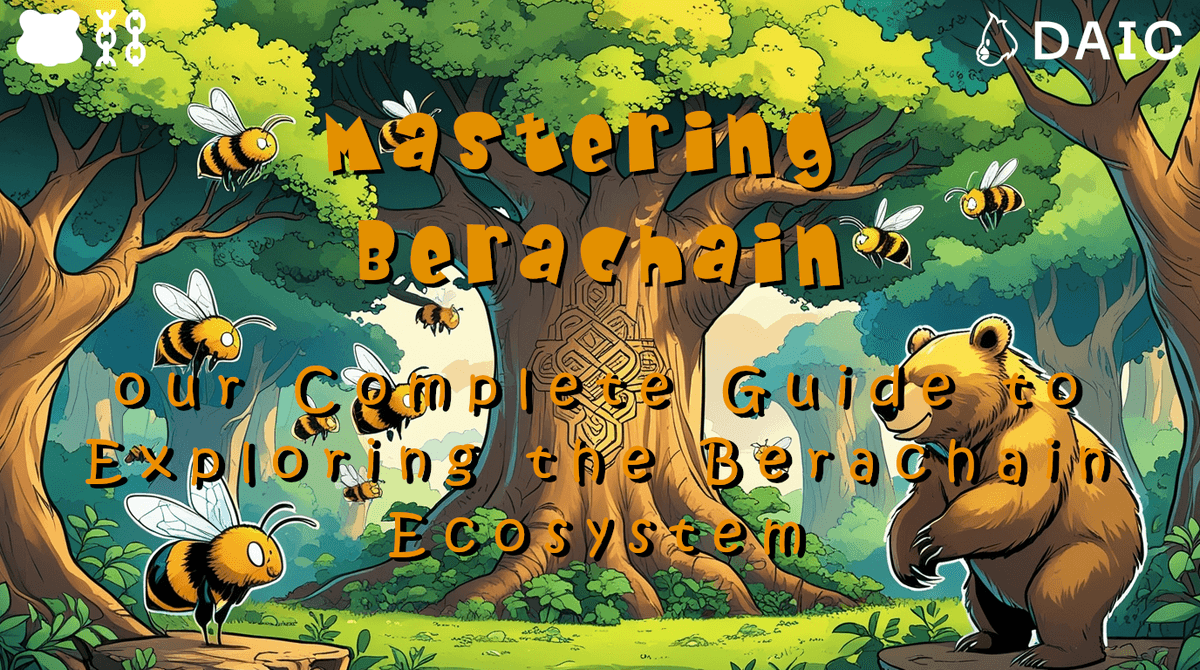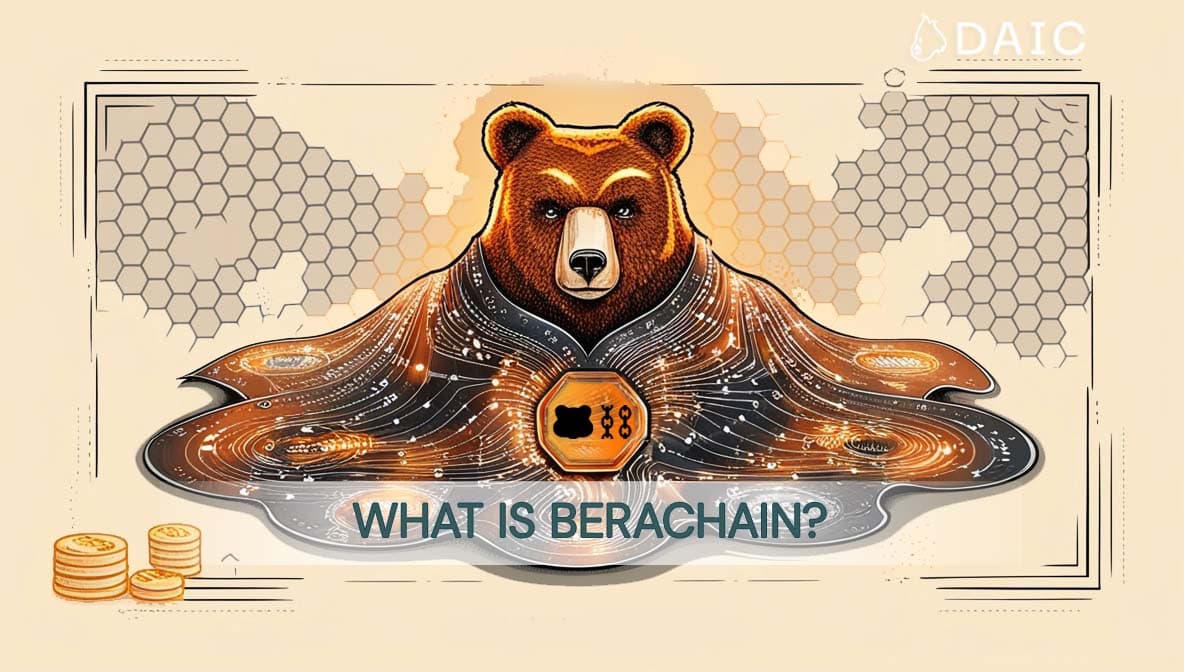Berachain is a new blockchain focused on DeFi, attracting much attention thanks to its innovative Proof-of-Liquidity model and "bear" themed community. But along with innovation come a whole bunch of new questions. This FAQ will answer several of the most common questions regarding Berachain and help guide you through this exciting ecosystem.
If you're interested in Berachain, explore our dedicated section filled with blog posts and comprehensive guides: https://daic.capital/blog/category/Berachain
Getting Started with Berachain
What is Berachain?
Berachain is a new, high-performance Layer 1 blockchain built for DeFi. It utilizes the BeaconKit consensus framework and is fully compatible with Ethereum. Unique to it is Proof-of-Liquidity (PoL): a system that directly rewards all participants for contributing to a healthy and liquid trading environment by providing liquidity. You can learn more about it in our article “What is Berachain and Why Should I Care?”
What Makes Berachain Special in the DeFi Ecosystem?
Berachain is special for three reasons:
- Proof-of-Liquidity: Instead of staking conventionally, Berachain incentivizes users for their liquidity provisioning to dApps. This brings better alignment and more activity to the ecosystem.
- Tri-Token System: Berachain uses three different tokens, namely, $BERA, $BGT, and $HONEY, in an optimized way for different functions such as gas, governance, and stability.
- Community-Driven Governance: The $BGT token, accruing through PoL participation, directly gives users a voice in the future of the platform.
What is Berachain’s Proof-of-Liquidity (PoL)?
Proof-of-Liquidity (PoL) is Berachain's innovative consensus mechanism that rewards users for contributing to the liquidity of decentralized applications (dApps) built on Berachain. By providing tokens to trading pools you earn $BGT, Berachain's governance token, and directly contribute to a more vibrant and efficient DeFi experience for everyone. You can learn more about it in our article “Berachain's Proof-of-Liquidity: A New Era of DeFi Collaboration”.
What is the difference between Proof-of-Stake (PoS) and Proof-of-Liquidity (PoL)
Traditional Proof of Stake usually is concerned with just network security through staking. Berachain's Proof-of-Liquidity extends this very basic focus to directly align the incentives of the user, validator, and dApp. Incentivize users to supply liquidity, Validators are incentivized to support both the network and valuable dApps, and dApps are incentivized to attract users and validators. This creates a three-way alignment that delivers a more dynamic, efficient, and rewarding experience in DeFi.
Which Wallets are Compatible with Berachain?
For the most part, Berachain is currently compatible with a wide variety of extremely popular crypto wallets that you may be using. Since it is EVM-compatible - MetaMask and Coinbase Wallet will work just fine, among many others. The best wallet is determined by your needs. Check our article, "Choosing Your Berachain Wallet," to explore secure, user-friendly options.
How to Add the Berachain Network to My Wallet?
You will have to add the network details of Berachain, such as RPC URL and Chain ID, among others, to your wallet. You can find the official guide on how to do this in the Berachain documentation.
What are Berachain's Block Time and TPS?
- Block time: 2sec
- Transactions per Second (TPS): Calculated as (Block gas limit (30m) / Average gas limit per txn) / Block time (2s) = up to 375 TPS.
- Finality: Single slot finality.
Berachain's Tokens: $BERA, $BGT, and $HONEY
What is BERA?
$BERA is Berachain's native gas token, meaning you need it to pay for any transaction on the network, like sending tokens or using dApps. It's also essential for network security, as validators stake $BERA to participate in consensus. Think of it as the fuel that keeps Berachain running. You can find a more detailed explanation in our article.
What is BGT?
$BGT is Berachain's governance token, but unlike many other governance tokens, you cannot buy it. You can only earn $BGT by actively participating in Berachain's Proof-of-Liquidity system, primarily by providing liquidity to dApps. $BGT gives you voting rights on proposals, allowing you to influence Berachain's development, and it also lets you "boost" validators to earn a share of their rewards.
What is HONEY?
$HONEY is Berachain's native stablecoin, designed to hold a steady value close to one US dollar. This makes it a reliable tool for trading, lending, borrowing, and other DeFi activities within the Berachain ecosystem, minimizing price volatility.
How to get BGT?
You earn $BGT by actively participating in Berachain's Proof-of-Liquidity system. The primary way to do this is by providing liquidity to approved decentralized applications (dApps) and then staking the receipt tokens you receive in Reward Vaults. You can also earn $BGT by borrowing the $HONEY stablecoin on the BEND lending platform. For a step-by-step guide, see our article “How to Earn $BGT on Berachain”.
How to get BERA?
You can get $BERA in a couple of ways:
- Centralized Exchanges (CEXs): Many centralized exchanges list $BERA. You can buy it there using other cryptocurrencies or fiat currency (like USD).
- Decentralized Exchanges (DEXs): Once you have some assets on Berachain, you can swap them for $BERA on BeraHub. Also, if you have BGT, you can burn it for BERA at a 1:1 ratio.
- Bridging: If you acquire $BERA on a centralized exchange or already have assets on another blockchain, you can use a bridge to transfer them to Berachain. The official Berachain Bridge, powered by LayerZero, is recommended for secure transfers.
How to get HONEY?
There are two primary ways to obtain $HONEY, Berachain's native stablecoin:
- Mint $HONEY: Use the HoneySwap dApp to deposit accepted collateral assets (such as BYUSD) into designated vaults. This process creates new $HONEY, and the amount you can mint is determined by the specific collateral and rules set by $BGT governance.
- Swap for $HONEY: You can acquire $HONEY by exchanging other cryptocurrencies for it on BeraHub. This is a quick and easy way to get $HONEY if you already have other assets on Berachain.
Proof-of-Liquidity and Rewards
How to Earn Rewards with Berachain?
You can earn rewards by providing liquidity to approved Berachain’s dApps, staking the receipt tokens in Reward Vaults, and optionally delegating your earned $BGT to validators.
What is Liquidity in DeFi?
Liquidity refers to how easily an asset can be bought or sold without significantly impacting its price. In DeFi, it often refers to the availability of tokens in trading pools.
What is APY in DeFi?
APY stands for Annual Percentage Yield. On BeraSwap, it refers to the estimated yearly return for providing liquidity to a given pool. This yield typically comes from trading fees collected on swaps.
What are Liquidity Pools?
Liquidity pools are reserves of two or more tokens held on a decentralized exchange that facilitate trading between those tokens.
What is a Liquidity Provider on Berachain?
Liquidity providers are users who deposit tokens into liquidity pools. They are rewarded with a portion of the fees that are generated from swaps in the pool, and with $BGT tokens.
What are Receipt Tokens (LP Tokens)
Receipt tokens, also known as LP tokens, are tokens you receive when you provide liquidity to a pool. They represent your share of the liquidity pool, and you can use them to earn $BGT.
What is a Reward Vault on Berachain?
A Reward Vault is a smart contract on Berachain – the only place you can earn $BGT. You stake the receipt tokens you get from providing liquidity (or other qualifying actions on approved dApps) in these vaults. Validators then direct their earned $BGT emissions to these vaults, and you receive a portion based on your staked amount. Learn more in our dedicated article “What is a Reward Vault? Your Key to Earning BGT”.
How Much BGT can a Reward Vault earn?
The amount of $BGT a Reward Vault earns depends on two main factors: how many validators are sending their $BGT rewards to that vault, and how much $BGT is "boosted" (delegated) to those validators. More validators directing rewards, and higher boosted amounts, mean more $BGT for the vault and its participants.
How to claim BGT Rewards After Providing Liquidity on Berachain?
Each eligible (whitelisted) pool on Berachain has an associated LP token. Once liquidity is deposited into a pool, an LP token would be issued relative to the users total contribution percentage to the pool. With this LP token, users stake (take an additional action) them into their respective Reward Vaults in order to be eligible to receive $BGT. Then users need to claim $BGT in BeraHub, it is NOT automatically sent to the user.
Staking on Berachain
What Does "Staking" Mean on Berachain?
- Validators staking $BERA: To secure the network and become eligible to propose blocks.
- Users staking LP tokens: To earn $BGT rewards in Reward Vaults after providing liquidity.
- Users delegating $BGT: To "boost" a validator and earn a share of their rewards (this is often called "staking" $BGT).
How to Delegate $BGT?
You can delegate your $BGT through the BeraHub. You'll need to connect your wallet, choose a validator from the list, and then delegate your desired amount of $BGT. Read more in our guide - How to Stake $BGT: A Step-by-Step Guide
How to Choose a Berachain Validator ?
Consider factors like the validator's past performance, uptime, commission rate, and their alignment with projects you support. You can find information about each validator on BeraHub. Also, some validators offer a portion of the extra incentives they receive from dApps for directing rewards to their vaults.
Berachain's Proof-of-Liquidity model opens a completely different paradigm in DeFi, and understanding these basic terms is the first step to becoming a part of this exciting ecosystem. As you delve deeper into Berachain, refer to the official documentation and reach out to the amazing community. The "Beras" will always be there to support you!
Take a step further in your learning journey with this extended glossary, "Decoding Berachain: A Glossary of Key Terms".
The information provided by DAIC, including but not limited to research, analysis, data, or other content, is offered solely for informational purposes and does not constitute investment advice, financial advice, trading advice, or any other type of advice. DAIC does not recommend the purchase, sale, or holding of any cryptocurrency or other investment.


